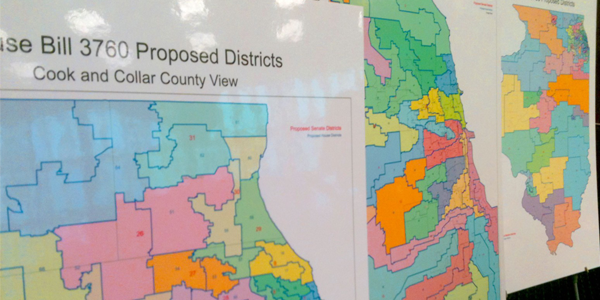
Illinois Redistricting Plan Is Unconstitutional: It Should Really Be As Easy As 1, 2, 3!
Written by James M. Odom
Article 1, Section 2, Clause 3, of the U.S. Constitution requires legislative districts to be based upon an actual count of population every 10 years. The Illinois Constitution also requires this.
The procedure for drawing legislative districts prescribed by the Illinois Constitution is for the Legislature to complete a redistricting plan for legislative districts according to the new federal census, in the year following the census.
If the redistricting plan is not complete by June 30th, a commission of 8 members (half to be non-legislators), appointed by July 10th by each of the majority and minority political leadership, “no more than four of whom shall be members of the same political party,” will complete the redistricting plan.
If the plan is not complete by August 10th, the Illinois Supreme Court will add a member from a random drawing between two persons, “not of the same political party.” Redistricting is to be complete by October 5th.
The Illinois Constitution gives the state Supreme Court “original and exclusive jurisdiction over actions concerning redistricting.”
The U.S. Census Bureau currently indicates that its production of population data necessary for redistricting is delayed until August 16, 2021.
Therefore, for their own political gain, the Governor and Cook County Democrats in overwhelming control of the Illinois Legislature, chose to ignore the requirement of Census data in both the U.S. and Illinois Constitutions, and instead substituted estimates, so that they could control the districts, rather than the commission required by the Illinois Constitution.
On Wednesday, June 9th, Illinois Senator Dan McConchie (R-Lake Zurich), and State Representative Jim Durkin (R-Burr Ridge) filed a lawsuit in the United States District Court for the Northern District of Illinois, to invalidate the just-enacted legislative redistricting plan as unconstitutional.
Republican Party leadership in the Illinois Legislature should be commended for challenging the ongoing tyranny of the Democrat majority in unconstitutionally and arbitrarily drawing new legislative districts to suit their own political ends. However, their approach to the suit is wrong-headed.
“A republic, if you can keep it.” ~Ben Franklin
This action by the legislature is just the latest assault on the citizenry’s desire to remain a Republic.
Article 4, Section 4 of the U.S. Constitution, while frequently brushed aside or overlooked, guarantees all states a “Republican form of government.”
The word “republic” comes from the Latin term res publica literally meaning, “the public thing” and is understood to mean government according to the rule of law. First and foremost, in the United States Republic, that law is based upon securing the rights endowed by our Creator.
“We hold these truths to be self-evident, that all men are created equal, that they are endowed by their Creator with certain unalienable Rights, that among these are Life, Liberty and the pursuit of Happiness.–That to secure these rights, Governments are instituted among Men” ~Declaration of Independence
The Illinois Constitution is the rule of law designed precisely to prevent the tyranny of the majority of Cook County Democrats currently ruling over the citizens of the State of Illinois.
Instead of our federal guarantee of a republican form of government, the lawsuit relies primarily on bad Supreme Court precedent [1], which as Illinois Senator Everett Dirksen forecast in 1964, has helped to disenfranchise a large minority of voters throughout Illinois.
In Reynolds v. Sims, the Warren Court (the same which gave us Roe v. Wade) added the new legislative edict, of (only) “one person, one vote.”
This “rule” is the foundation for the Democrats’ redistricting strategies, rather than a prohibition of them, and should be refuted, rather than endorsed as “established law” as this suit does.
The Republican Party should realize that the very difference between its name, and that of its nemesis, is really the key issue.
Relying upon the plaintiffs’ theory also makes the case’s arguments more difficult, trying to establish a substantial deviation between the estimated data used by the Democrats and the eventual census data. [2]
Though lengthy and tangled opinions have become the order of recent years in the federal courts, a quick and short opinion should be issued:
- Declaring the redistricting plan void for violation of Article 1, Section 2, Clause 3 (Apportionment of representatives by census), and Article 4, Section 4 (Republican form of government) of the U.S. Constitution.
- Issuing a permanent injunction preventing implementation of the redistricting plan in any way.
- Ordering the State to pay statutory fees for defending Constitutional rights in court.
- Refusing to issue a Writ of Mandamus or order dictating how Illinois officials will complete the redistricting plan, as it is already designated and placed under the jurisdiction of the Illinois Supreme Court, by the Illinois Constitution.
Footnotes:
1 See Justice Harlan’s dissent, exposing in detail Sims‘ radical departure from previous constitutional jurisprudence. https://en.wikisource.org/wiki/Reynolds_v._Sims/Dissent_Harlan. The majorities’ platitudes that “legislators represent people, not trees or acres,” that “citizens, not history or economic interests, cast votes,” or that “people, not land or trees or pastures, vote,” do not address the legitimate concern that people who are concentrated in a relatively tiny area of land, should not then be entitled to rule over citizens in the vast expanse of prairie farmland that may largely comprise the state, and be owned by those citizens. One could also rightly characterize these “lands,” “trees,” “economic interests,” and “history,” as “communities” where voters live, together. Sims, inconsistent with both history and the makeup of the federal legislature itself, practically legislates that ONLY population be considered, converting legislatures from republican government to the straight democracy our founders sought to avoid. This is why our Republic has the electoral college, and Senators by state at the federal level, so that candidates won’t just campaign in big cities of New York, Texas, Florida and California (or perhaps just the counties of Cook and DuPage as applied to Illinois).
2 Paragraph 5 of the complaint states that, “The Redistricting Plan uses the 2015-2019 ACS estimates, which reflect that Illinois has a total resident population of 12,770,577. However, the statewide 2020 decennial census count, which the Bureau released on April 26, 2021, indicates the total resident population of Illinois as 12,812,508 as of April 1, 2020. Thus, the five-year ACS estimates fail to account for nearly 42,000 Illinois residents counted in the decennial census.” This results in a .3% population deviation, far less than the presumptively Constitutional deviation of 10%.














